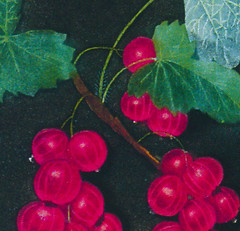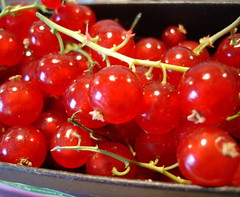Happy St. Jean! (rev. ed.)
 fig. a: red currants by George Brookshaw (detail)
fig. a: red currants by George Brookshaw (detail)
Yes, today is St. John the Baptist's feast day, one of the very oldest Christian feast days (quite possibly the oldest), a day that evolved into "la Fête Nationale" in these parts over the last two centuries due in part to St. John's status as the patron saint of Quebec and the tireless work of the St. Jean Baptiste Society. At one time one of the most hallowed of saint days, a day that rivalled Christmas in importance on the Christian calendar, St. John the Baptist's feast day has since gone overwhelmingly secular in Quebec, and like most celebrations of its kind, people typically celebrate "la St. Jean" with picnics, fireworks, barbecues, parties, and flag-waving and other such shows of pride. What many of you may not know, however, even those of you who live here in Quebec (we sure didn't until Michelle leafed through her brand new copy of George Brookshaw's Pomona Britannica the other day), is that not only is John the Baptist the patron saint of Quebec, he's also the patron saint of currants because of their tendency to ripen around the time of his feast day. This discovery changes everything! I've always had mixed feelings about the fleur-de-lys and its ancien regime associations anyway. From now on St. Jean's going to be all about the cassis in this household. Michelle's off to the market to see if she can't find some fresh currants for dessert and tonight we're planning on toasting The Precursor with a cassis-spiked apéro. Cheers!
Guess who just got back from the market? fig. b: red currants by Mother Nature
fig. b: red currants by Mother Nature
Not quite at their peak yet, but they're pretty close...
aj
(Pomona Britannica by George Brookshaw is yet another one in the lovely series of botanicals Taschen has been reprinting over the last several years.)









6 comments:
Wonderful news about the currants! I was just wondering whether St. Jean Baptiste is the patron saint of fresh currents (cassis) or dried currants, which you probably know are actually are a different species entirely, and are dried miniature grapes. The word "currant" comes from "Corinth" where these grapes were originally harvested. I wonder if it's actually the dried variety, since those are more typically associated with the middle east and the spice trade (and hence, with John the B). Either way, it's a great way to cook up something new!
hi muse,
St. Jean Baptiste is definitely the patron saint of fresh currants according to our sources. It's all got to do with the correlation between the 24th and peak season for fresh currants. We had ours with a creamy cheese on crackers. Dee-lish!
Avid fan of both St. Jean Baptiste day and An Endless Banquet that I am, I thought I'd share this delicious bit of baking that appeared all over Barcelona for the holiday: Pa del San Juan, a sweet bread decorated with candied fruit and pine nuts. Underneath the colourful fruits, it was anise flavoured and light, with a biscotti-like crumb.
Hi Delire,
Wow, that looks and sounds amazing. "La St. Jean" is a good time here, but there definitely aren't enough specialty pastries (a sure sign that things have gone way too secular). Thanks so much for the link. I'm going to try and dig up a recipe so our resident pastry chef here can work on some tests for next year.
Ah! Now I know why currants are called "johannisbeeren" (john berries) in German.
I know a great recipe for a German currant tart if you're interested. Basically, a buttery crust topped with currants mixed in beaten egg whites. Really, really good stuff.
Hi Amy,
I had the same reaction. I'd always wondered about that name, too.
We're definitely interested in the German currant tart recipe. Please send it along if you get a chance.
cheers
Post a Comment